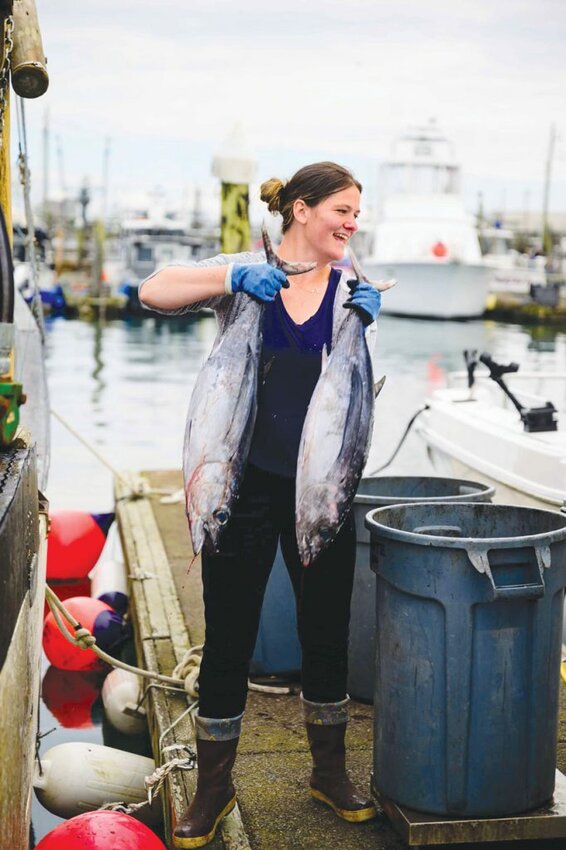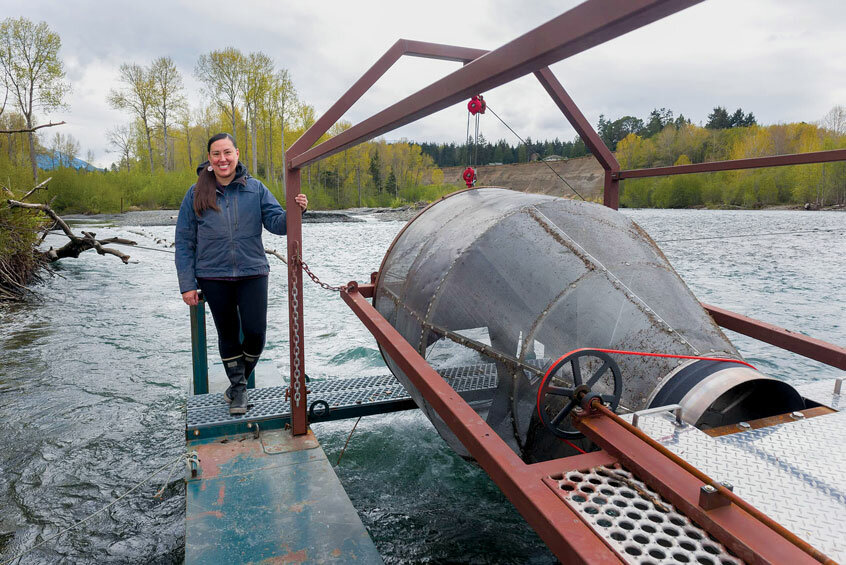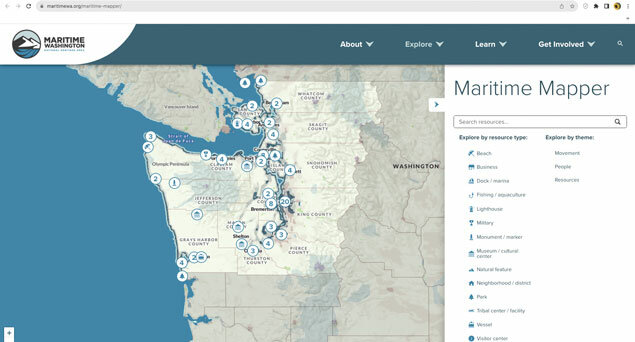 Mikayla Evans of Seafood Connection in Westport, WA loads a 50-gallon pail with tuna so they can be weighed and then moved to the ice box to await processing. This photo is part of a series about our state's vibrant working waterfronts, available at maritimewa.org. Photo by Jeremy Johnson.
Mikayla Evans of Seafood Connection in Westport, WA loads a 50-gallon pail with tuna so they can be weighed and then moved to the ice box to await processing. This photo is part of a series about our state's vibrant working waterfronts, available at maritimewa.org. Photo by Jeremy Johnson.When Jessica McVey closes her eyes at her home in the forest of Point Roberts on a quiet day, she can hear the ocean’s high tide calling to her.
Twenty years ago, McVey swapped the golden state of California – which she said was always more dusty brown anyway – for the evergreens of Washington state.
“Once you’re here for a while, you get what’s called the Point Roberts Awe,” she said. “You cross the border and come down Tyee Drive surrounded by evergreens on both sides. Straight ahead is the Salish Sea, and across the way is Orcas Island. It’s just gorgeous.”
Point Roberts’ rich history of maritime culture compelled McVey to attend a meeting for the local historical society. Three months later, she found herself as the organization’s president.
In her five years with the Point Roberts Historical Society, she worked on projects such as the town’s new history center and a history trail currently in progress. A consistent goal for McVey has been getting people to visit the secluded community of just over 1,000 residents, according to the 2020 census.
“We are extremely isolated,” she said. “Covid-19 really made that obvious.”
Travel was limited in and out of Point Roberts to essential trips only during the pandemic due to the town’s unique position about 25 miles past the Canadian border before re-entering the U.S. and traveling down the tip of the Tsawwassen peninsula.
Earlier this year, the nonprofit Washington Trust for Historic Preservation and the National Park Service officially launched the Maritime Washington National Heritage Area. The project works to connect 3,000 miles of maritime communities from West Point to Point Roberts in a network for upcoming events, celebratory stories and historical insights.
“We spent a long time planning for this program,” program director Alex Gradwohl said. “We had three years where we did a lot of listening to folks about what they wanted to see from this program, what they found to be special about maritime heritage in Washington. And so now we get to start implementing what we heard there.”
The organization’s website, maritimewa.org, was launched earlier this year and is dedicated to sharing and celebrating stories from various maritime communities within the heritage area. The interactive Maritime Mapper highlights almost 100 locations, including beaches, parks and tribal centers stretching along Washington’s coast.
When McVey discovered the Maritime Washington project, she reached out, hoping to have Point Roberts featured. Lily Point Marine Park is now the northmost destination on the Maritime Mapper. She hopes the addition of a state-wide resource will help bring more tourism up to the Point Roberts community.
“We encourage people to come visit because it is beautiful,” McVey said, adding that the historic canneries that surrounded Point Roberts on three sides were once the heart of the town’s industry.
 Vanessa Castle, fisheries and wildlife technician for the Lower Elwha Klallam tribe, stands on one end of a rotary screw trap - a piece of equipment used to determine the numbers of juvenile salmon in the Elwha River. Visit maritimewa.org to read Vanessa's story and learn more about the women that work Washington's shores. Photo by Pat Beggan.
Vanessa Castle, fisheries and wildlife technician for the Lower Elwha Klallam tribe, stands on one end of a rotary screw trap - a piece of equipment used to determine the numbers of juvenile salmon in the Elwha River. Visit maritimewa.org to read Vanessa's story and learn more about the women that work Washington's shores. Photo by Pat Beggan.Gradwohl said maritime towns up and down the Washington coast are sharing similar sentiments about finding a way to bring tourism in and get people excited about maritime culture.
“There’s all these people who know the resources really well, and they’re like, ‘we have these great resources, and people don’t know about them.’ And then we heard from the public, ‘I want to do maritime stuff, but I don’t know where to go,’” Gradwohl said. “I was like, great, this is our role. We’re the matchmaker.”
Maritime Washington chronicles stories from the waterfront, such as the Women on the Waterfront series and trip itineraries, including a three-day tour through the San Juan Islands and a Bellingham seafood journey. As of now, Gradwohl said she’s looking forward to getting more people aware of their presence.
More trip itineraries, newsletters and stories celebrating the cultural significance of maritime communities are in the works, Gradwohl said. Maritime Washington has also been involved with the ongoing construction of the Northwest Maritime Center in Port Townsend.
“Developing interpretive projects always takes a long time because you have so many different voices that you want reflected there,” Gradwohl said. “The Northwest Maritime Center, in particular, is being very thoughtful about the way that different communities and tribes contribute. That kind of collaboration just takes a lot of time.”
Grassroots style collaboration is a value Gradwohl said Maritime Washington strives for. The organization’s partners range from competitive boating groups to city governments to historical societies throughout the heritage area.
“Working with this range of partners has been overwhelming in the best way possible,” Gradwohl said. “What I found is really consistent is the passion, like, people care a lot. I think that’s a wonderful thing to be harnessed.”
In Bellingham, maritime culture culminates at the annual SeaFeast, a celebration of food, culture and industry, held on the second weekend in October. SeaFeast and the Working Waterfront Coalition of Whatcom County (WWC) got involved with Maritime Washington this year.
“There needs to be a better understanding of our waterways and the responsibility we all must have in preserving the healthiness of our oceans and respecting the people, traditions and culture that help make our waterways what they are,” said SeaFeast program director Kevin Coleman in an email.
Dan Tucker, WWC program manager sees the rich maritime roots of his own community and is excited for the opportunity to continue working with other like-minded organizations state-wide.
“Every community along our waterfront, I think, feels and recognizes the importance of what we have here,” Tucker said in an email. “All of them know that it will be a community-led effort to preserve and improve it.”
Within the heritage area are the traditional lands of 21 federally recognized tribes, many of which Gradwohl said already have robust maritime education resources for community members and visitors. She hopes to continue to foster a place where maritime and tribal communities can celebrate their unique cultures as well as their common ties to the salt waterways.
“Often people hear heritage, and they think of the past when really I think heritage are the things that we get from the past that influence today,” Gradwohl said.
Tucker values Bellingham’s enduring maritime industry background in commercial fishing fleets, logging, paper mills and shipbuilding.
“Every trade you can think of associated with the maritime sector has, or still does, business in this region – woodworking, metal fabrication, foundries, yards – you name it,” he said.
Part of the Bellingham maritime mission is to not only celebrate the tribal communities and historic industries, Tucker said, but to maintain and preserve these ways of life in the future. He said Maritime Washington’s goal of getting the public invested in the waterfront as being accessible to the public can go a long way in making sure it stays that way.
“The more that the public is aware of what their waterfront can provide them – recreation, industry, culture and connection – the more they will seek to preserve the balance of use along the waterfront,” he said. “Once you allow the waterfront to over-develop with exclusive, expensive and restrictive properties, it never goes back. The culture and connection to the place and to the people can become lost forever.”
With the sun still setting on summer, Gradwohl said Maritime Washington is looking forward. Plans are underway to compile a list of regional maritime celebrations in time for next summer.
“I swear if you’re willing to drive, you could probably go to one maritime festival every weekend from Memorial Day to Labor Day,” she said.
 A screenshot of the maritime mapper on maritimewa.org. Find a heritage park near you.
A screenshot of the maritime mapper on maritimewa.org. Find a heritage park near you.As a fellow Washington transplant from the Midwest, Gradwhol knows what McVey means when she said the beauty and heritage of the Pacific Northwest can’t compare to other regions.
Getting to know Washington’s maritime culture has helped Gradwhol plant her own roots as a Washingtonian, she said.
“The more you know about a place, the more you care for it and the more you want to take care of it, and I think that that’s a really powerful tool,” she said. “You can’t underestimate the power of getting to know the place that you live better.” X